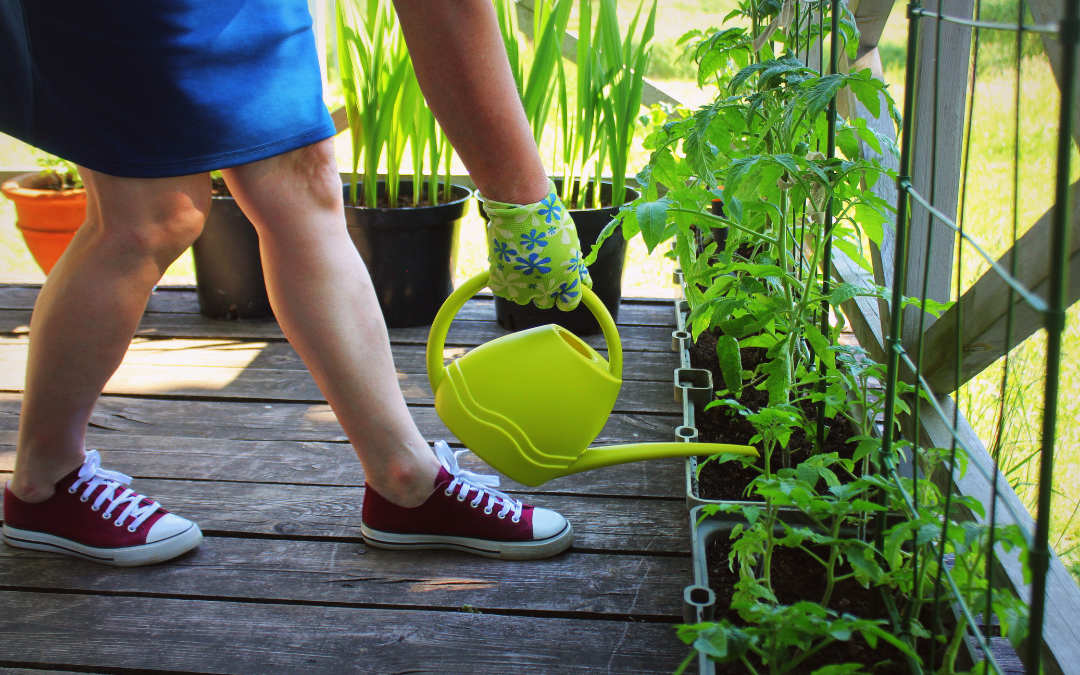Spring is just around the corner! You may be using this time to clean out last year’s garden beds, or to collect seeds for this summer’s harvest. But many of us lack the space or flexibility around our homes to enjoy the process of growing our own vegetables. This is where container gardening comes in – many plants can actually grow well in containers placed on a porch or patio, a method that also allows you to extend the growing season. You can start your garden indoors in the spring, move the containers outside during the summer, and then shift them back indoors in the fall to protect them from frost.
So how can you get started with a container garden? Here are a few things to keep in mind:
- Choosing a Container: It’s important that your containers have holes in the bottom so that water can drain out. Most vegetables will do best in containers that hold 2 to 5 gallons of soil and are at least 12 inches deep. You can use a variety of things as a container: barrels, flowerpots, milk jugs, bleach bottles, window boxes, baskets, tile pipes, cider blocks, etc.
- Adding Soil: It is recommended to use commercial potting soil for container gardening, but this may be too lightweight to provide adequate support for plant roots. You can try adding soil from the ground or compost to provide bulk and weight to your potting soil.
- Planting Your Seeds: Carefully clean out the container and fill it with your soil, leaving a ½ inch at the top with a slightly dampened soil. Plant your seeds and water gently, taking care not to wash out the seeds.
- Keeping Your Plants Healthy & Happy: Check your seed packets to see how much sun and space your plants need, and make sure to water your containers whenever the soil feels dry. Container plants tend to dry out and lose nutrients faster than plants in the ground so it is important to keep up with watering and fertilizer. Try using a water-soluble fertilizer every 2 to 3 weeks.
There are some vegetables that grow particularly well in containers. Oregon State University in partnership with their Food Hero program has collected a list of these vegetables, along with some growing tips:
- Beans and peas: Plant one sprouted seed or seedling in a 5-gallon container for best results. Provide a pole or trellis for pole beans and peas.
- Beets: Choose a container at least 12 inches deep.
- Carrots: Choose a shorter carrot variety and plant in a container at least 12 inches deep.
- Cucumbers and summer squash: For best results, choose a bush variety rather than a vine variety. A pole or trellis in the pot will help support the plant and allow air to flow around the leaves.
- Herbs: Many herbs grow well in containers, including basil, chives, cilantro, mint, oregano, parsley, sage and thyme.
- Peppers: All peppers like to have support, but it is especially important for varieties that produce large peppers. Use a stake or tomato cage to keep them upright
- Potatoes: Containers should be at least 18 inches wide and 3 feet deep to allow the most potatoes to grow. Look for varieties of certified seed potatoes that mature in 70 to 90 days.
- Radishes: Containers 4 to 6 inches deep work well for this cool-season vegetable that grows quickly.
- Salad greens: These cool-weather vegetables can be grown from spring to fall but may need shade during the heat of the summer. Cut the outside leaves when young and they will grow back for another harvest.
- Tomatoes: For best results, plant varieties designed for containers. They may have the word dwarf or patio in their name. Provide extra support with a stake or tomato cage.
It could end up feeling a little overwhelming to have dozens of pots on your front porch, but you might find that you enjoy having one or two vegetables in easily accessible containers. There’s a simple joy in being able to pick a few cherry tomatoes from your front porch the next time you’re putting together lunch.
Sources:
“Growing Your Own: A Practical Guide Gardening in Oregon” by Gail Langellotto, OSU Extension
“Growing Plants in Containers” by Food Hero and Oregon State University
Other wellness questions? Email us at info@tillamookcountywellness.org. For more local health and wellness information, visit www.tillamookcountywellness.org or follow Tillamook County Wellness on Facebook and Instagram.

